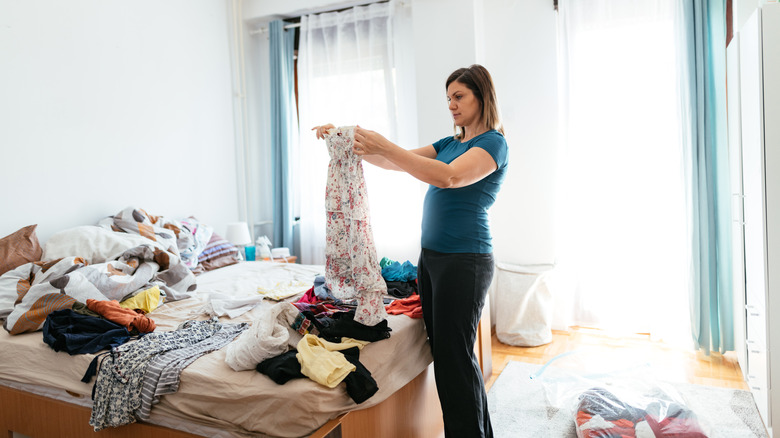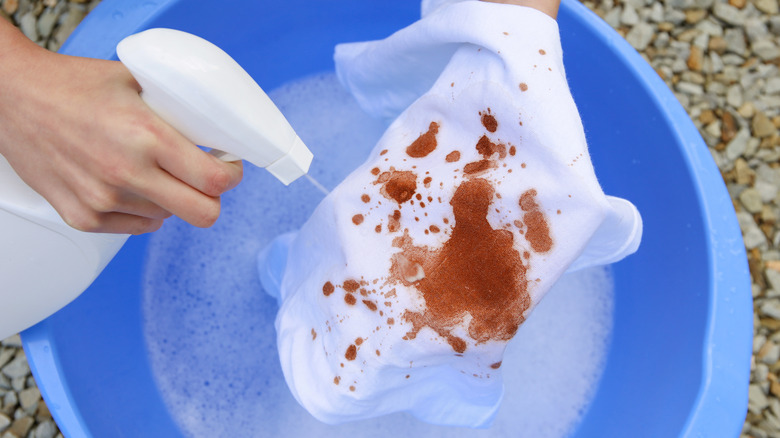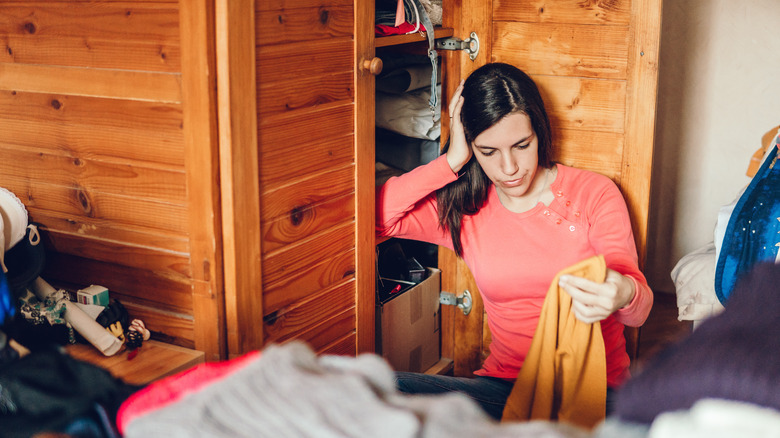The Biggest Mistakes To Avoid When Cleaning Your Closet
We may receive a commission on purchases made from links.
Although you might put it off, there comes a time when you really do need to clean and organize your closet. When you finally get around to tackling this project, you'll want to avoid mistakes that prevent you from making the most of your time and effort. Think of your closet-cleaning endeavor as a step-by-step process that produces a positive end result. But, if you fail to complete some of the steps, the result may be less than desirable.
For example, you might have trouble with sorting and dividing your clothing into categories, or you might inadvertently hang onto items that don't fit or that show signs of wear and damage. Common mistakes like these can sabotage your efforts and cause you to waste time in your closet-cleaning project. We've identified nine mistakes to avoid when cleaning your closet. Read on to discover how to turn these mistakes around and achieve a clean, organized, and inspiring place to get dressed for your day.
You don't begin your closet clean-out project with a definite plan
Like any project around the house, you'll be more successful with your closet clean-out if you approach it with a definite plan in mind. First, set aside a block of time for cleaning your closet. Then, gather the cleaning supplies and organizational tools you'll need for the job. These include clothing hangers, garment bags, and containers like clear, plastic bins. Next, you'll want to create organizational goals, such as eliminating all clothing that no longer fits you or donating duplicate items that you don't need.
Finally, it's a good idea to make an action plan for how you'll handle each of the items that you purge from your closet. If you have new or like-new clothing that you'll never wear again, you could sell the items on a resale website like Poshmark, ThredUP, or Mercari. As an alternative, you could take them to a local consignment shop. Before you begin the closet cleaning project, do some research and figure out where and how you'll sell the good-quality pieces that you no longer need or want. Similarly, you might investigate charitable organizations in your community that will accept donations of gently-used clothing and accessories. Select a charity that aligns with your values and make a definite plan to deliver your donated items immediately after you complete the closet cleaning.
You don't take everything out of the closet at the beginning of the project
If you make the mistake of leaving everything in your closet while you try to sort through the jumble, you may be doomed for failure from the start. Instead, you'll be more successful if you remove every item and work with the clean slate of an empty space. Gather up all of the clothing pieces, shoes, accessories, and miscellaneous stuff. Pile everything in one area, like on a bed, or any other clean spot from which you can work. When the closet is completely empty, you'll gain a visual idea of how you can use the space creatively to maximize your storage options. Additionally, you'll be able to determine how many items you can reasonably put back into the closet at the end of the project.
With everything out of the closet, you get the rare opportunity to begin assessing your clothing and accessory choices. Simply seeing it all laid out in a pile, you may start to realize that you don't need or want some of the items you've been holding on to. Emptying the closet shifts your perspective to evaluate your wardrobe in a new light. The simple act of observing your belongings in a different setting can motivate you to make decisions about what you want to keep and what you can relinquish to resale, charitable donations, or the trash bin.
You skip over the step of deep-cleaning the surfaces in your closet while it's empty
Although we rarely think about it, our closets do gather dust, and dirt builds up in those tucked-away corners. That's why it's crucial to include a deep cleaning of all surfaces in your closet clean-out plan. While your clothing and other items are lying in a pile away from their usual home, you have the perfect opportunity to accomplish this chore. Deep cleaning your closet not only makes it a more pleasant place to store your belongings, it can lead to a healthier environment for your family. Dusty conditions in your home may trigger allergies and asthma in some occupants. Tiny insects like silverfish and dust mites can proliferate in closets that don't get an occasional deep cleaning. These little bugs ruin your belongings by feeding on fabric and paper materials. Additionally, they trigger allergic reactions in humans.
While your closet is completely empty, you can start the deep cleaning task by vacuuming and dusting to remove loose, surface dirt and debris. Then, wipe down the shelves, rods, walls, and light fixtures with a microfiber cloth and a multi-purpose cleaning spray or liquid cleaner in a bucket of water. Next, thoroughly clean the carpet or flooring. If you detect unpleasant odors, spread a dusting of baking soda on the carpet, allowing it to sit for 15 minutes before vacuuming. After you finish the deep cleaning, leave the closet door open so that the small space can air out.
You don't try on your clothes and shoes to make decisions about what to keep
Once you've removed all the items from your closet and cleaned all the surfaces, it's time to decide which pieces you'll return to the closet for continued use. Don't make the mistake of simply grabbing stuff and cramming it back in. Instead, take the time to try on each item and carefully consider whether you should keep it, throw it away, or pass it along to someone else. This is especially true of clothing and shoes that you haven't worn in awhile.
The try-on process is best achieved in front of a full-length mirror. Carefully inspect how the clothing looks on you from front and back views, checking for proper fit. If a garment is too tight, too small, or poses problems due to a cut or design that doesn't suit your body type, it's a sure sign to get rid of it. On the other hand, if an item is too long or too large, it may benefit from an easy fix, like hemming or professional tailoring. After checking each piece for proper fit, make an assessment of whether you like the style. If it's outdated or does not fit your current lifestyle, it can go. While you're trying on the garments, check each item for stains and faults like ripped seams or loose buttons. Take care of these problems before you return the clothes to your closet.
You allow guilt to stop you from decluttering certain items
Sometimes, we hang onto wardrobe items because we feel guilty about letting them go. The knowledge that you paid too much money for it or that it was a gift from a loved one can make you hoard an item that you'll never wear. To avoid making this mistake, you'll need to shift your mindset. Instead of agonizing about parting with some of your clothing pieces, focus on how someone else will enjoy the clothes after you sell or donate them.
Carefully evaluate each garment and decide if you're really going to wear it. If not, you can adopt an attitude of joyful generosity as you donate or sell it to someone who might get tons of use from the item. On the other hand, a special piece of clothing that embodies sentimental meaning for you might be too precious to just pass along. In the case of heirloom clothing or an item that evokes cherished memories, you might simply store it in a memory box. That way, you'll preserve the item while freeing up space in your closet for clothing that you'll actually wear — and you won't feel guilty about it.
You fail to sort and divide your belongings into categories for further action
While you're evaluating each item in your closet, you'll need to make decisions about whether to keep it or discard it. Decide on a limited number of categories into which you'll sort and organize all of your stuff. For example, many people adopt the "Four Box Method." This is a technique where you start with four empty boxes labeled keep, donate/sell, toss, and storage, respectively. As you consider each wardrobe piece, place it in the appropriate box. At the end of this exercise, you'll have sorted the contents of your closet into four categories. Next, you'll need to follow through with the appropriate actions to complete the project.
When it comes to clothing, shoes, and accessories, you can think of additional categories for sorting your belongings, such as by season, color, or activity. For example, your workout clothing can be stored separately from business attire, and winter clothing can be stowed away during the summer. If you sort your clothing in categories, it's easy to see where you might have overspent on excess items and to purge your wardrobe as needed. Do you really need six white T-shirts simply because you think a white tee is a wardrobe staple? Do you really need eight pairs of gloves simply because you received them as gifts over the years? A closet clean-out is an ideal time to pare down duplicate items in defined categories.
You don't attend to mending, stain removal, and laundry tasks for your clothing
After evaluating whether your clothing pieces fit and whether they're appropriate for your lifestyle, the next step is to assess their condition. Don't make the mistake of hanging clothes in your newly cleaned closet if they're dirty or damaged. Instead, create a special pile of garments that need laundering and repairs. Take a close look to see if any items show fabric stains and take action to remove the stains immediately. With the help of an internet search, you can find the best methods for removing a plethora of stains, including coffee, wine, ink, and more.
In addition to verifying that your clothes are clean and stain-free, you'll want to inspect them for damage. Mend any rips or tears and sew on loose or missing buttons. The best way to complete this project is to give yourself a deadline. Set a timeframe of two weeks, a month, or whatever you decide. Then, take action to ensure that all of your clothing is stain-free and in good repair. If some items remain in the to-do pile after the set deadline, you're probably never going to wear them, anyway. It's time to move them out of your closet permanently by discarding or donating them.
You fail to develop an organizational plan that maximizes your closet space
Kudos on your diligent work in cleaning your closet and making decisions about the items that you'll keep for future wear. Now, it's time to return much of your wardrobe to the closet and set it up for ease of use. Don't make the mistake of simply cramming your stuff into the closet without an organizational plan. Instead, this is your opportunity to arrange the space so that you can store more items while keeping everything clean and in excellent condition. On top of that, a well-organized closet makes it easy and enjoyable to get dressed every morning.
Start by dividing your wardrobe pieces into categories, such as tops, bottoms, outerwear, and accessories. Hang your clothing on uniform hangers like the slim velvet hangers from Amazon. Then, look for available wall space where you can install hooks or shelving to utilize the vertical space for storage. You really don't need to spend money on your closet clean-out project, but you might enjoy using a few helpful items like the hanging jewelry organizer from Amazon or the over-the-door shoe organizer from Walmart.
You can keep your folded clothes dust-free by storing them in see-through containers like the clothing storage boxes with clear windows from Walmart. In this last phase of your project, you'll want to discover creative ways to use the closet space so that you can protect the wardrobe items while keeping everything visually accessible and within easy reach.
You think you have to reorganize the whole thing in one go
Although it's ideal to think that you can devote several hours to cleaning out your closet, the truth is that real life gets in the way. Your busy schedule might not allow a full afternoon for the job, or you may feel overwhelmed at the prospect of making it a time-consuming task. Instead of doing it all at once, you can clean and organize your closet one section at a time. For example, you might dedicate an hour to sorting through your shoes, setting aside some of them to discard or donate, and cleaning your shoe-storage area. Then, on a day where you can squeeze in another hour of closet cleaning, you can move on to your pants, tops, or workout clothes.
Instead of doing a marathon cleaning project, you can divide and conquer by doing the wardrobe organization and closet tidying on a regularly recurring basis. The experts at MasterClass recommend that you re-evaluate and declutter your closet every few months. Perhaps as each season draws to a close, you might do a quick inventory and clean-out. This doesn't need to be an hours-long session, but regular attention to the task will help you to maintain a pleasant and efficient closet space where you happily get dressed every day.









